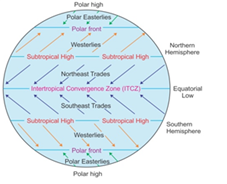ICSE Class 9 Answered
Explain the following pressure belts with the help of a suitable diagram:
Equatorial Low Pressure Belts
Sub Tropical High Pressure Belts
Circum- polar Low Pressure Belts
Polar High Pressure Belts
Asked by Topperlearning User | 22 Dec, 2015, 12:17: PM
The four major pressure belts of the Earth are:
- Equatorial Low Pressure Belt
- This belt lies between 00 to 50N and 00 to 50S.
- Since the vertical rays of the Sun fall on the Earth, the heat is intense and the temperature is high. The air becomes warm and expands.
- The convection currents help to spread the heat to the upper layers of the atmosphere also.
- This leads to the creation of a low pressure belt in the region. Winds in this pressure belt do not blow at a fast pace and hence this belt is also known as the Belt of Calms or the Belt of Doldrums.
- Sub tropical High Pressure Belt
- This belt is located between 300N to 350N and 300S to 350S.
- As the air at the Equator moves towards the Poles, it begins to cool and sink down at about 300 North and South of the Equator. This creates areas of high air pressure.
- Due to the rotation of the Earth, air from 600N and 600S also descends in the Sub tropical Belts.
- This pressure belt is also a Belt of Calms and is referred to as the Horse Latitudes.
- Circum-polar Low Pressure Belt
- This belt is located between 600N to 650N and 600S to 650S.
- It is a zone of two winds; the warm Westerly winds meet the cold polar Easterlies. As the Westerlies are lighter, they rise over the cold polar winds creating low pressure area.
- These belts experience stormy weather and cyclonic activity especially during the winters.
- Polar High Pressure Belts
- This belt is located between 850N to 900 N and 850S to 900S.
- The Polar regions experience cold climatic conditions as the rays of the Sun are extremely slanting.
- The cold air sinks down giving rise to high pressure areas.
- In places where the temperature is permanently low, the air is dense and heavy. These Polar regions have permanent ice caps.

Answered by | 22 Dec, 2015, 02:17: PM

